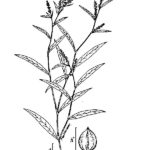Persicaria hydropiperoides (Polygonum hydropiperoides)
USDA, NRCS. 2018. The PLANTS Database (http://plants.usda.gov, 28 March 2018). National Plant Data Team, Greensboro, NC 27401-4901 USA.
Illustration: USDA-NRCS PLANTS Database / USDA NRCS. Wetland flora: Field office illustrated guide to plant species. USDA Natural Resources Conservation Service.
What is Waterpepper Smartweed?
Physical Characteristics
Leaves:
- Many
- Sword-shaped
- 2-9.5 inches long
- Up to 2.5 inches wide
- Fleshy
- Small at base
Flowers:
- 2 spikelets over 1.5 inches long
- Greenish to white or pinkish in color
- 0.09-0.13 inches long
- Fleshy on outside
- 5 lobes
- 8 stamen
Fruit:
- Dark brown or black in color
- Smooth
- Shiny
- 0.06-0.13 inches long
Stem:
- Up to 6 feet long
Roots:
- Rooting freely at nodes
Where Does it Grow?
Waterpepper smartweed can be found in marshes, wet meadows, streams, ponds and lakes. Sometimes, they form mats in streams.
Pros and Cons of Waterpepper Smartweed
Smartweed seeds are heavily consumed by ducks, small birds, and small mammals. Submerged portions of all aquatic plants provide habitats for many micro and macro invertebrates. These invertebrates in turn are used as food by fish and other wildlife species (e.g. amphibians, reptiles, ducks, etc). After aquatic plants die, their decomposition by bacteria and fungi provides food (called “detritus”) for many aquatic invertebrates.


